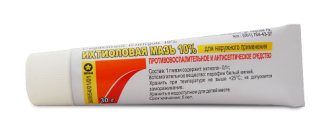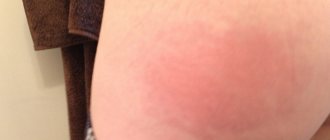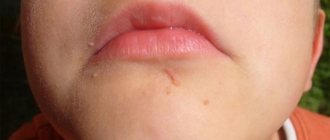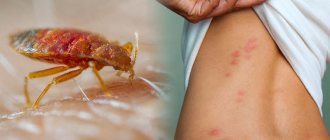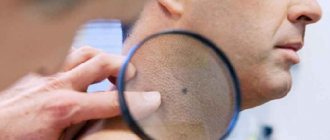A furuncle is a purulent-inflammatory process that involves the hair follicle, sebaceous gland and subcutaneous fat. An abscess occurs when the body's defenses decrease. A seemingly harmless inflammatory element should not be underestimated; the consequences of a boil can significantly disrupt the functioning of organ systems and limit motor activity.
Why is a boil dangerous?
A single boil, with a limited infiltration zone and small size, does not lead to serious consequences. The abscess may have a deep necrotic core. The danger lies in the outwardly inconspicuous inflammation degenerating into a deep purulent abscess of the tissues surrounding the affected follicle.
The most dangerous location of a purulent abscess: face, chin, nasal passages. The close location and direct communication of the facial sinuses with the brain increases the risk of developing severe complications. Brain damage is unpredictable; a clinical picture with the shutdown of certain zones can develop at lightning speed. In the future, this will result in memory loss, loss of vision and hearing, and death is possible.
Many patients, especially children and adolescents, do not attach much importance to the boil. It is believed that an ordinary pimple has popped up and is festering. They attempt to open it themselves, but it is not always possible to squeeze out the pus. The consequences of such actions are blood poisoning, spread of pus into surrounding tissues, phlegmonous processes, thrombophlebitis and chronically recurrent furunculosis.
How to deal with compaction
In order to cope with compaction after a boil (its immediate consequence), it is necessary to use anti-inflammatory and wound healing agents.
Such ointments help to cope with the abnormal collagen filling the wound left by the boil. This approach will allow you to say goodbye to the boil without unpleasant cosmetic defects. The skin will remain the same as before the development of the infectious-inflammatory process. this will preserve the beauty of the skin and restore the flow of metabolic processes in it for the correct performance of its functions.
They will speed up the process of smoothing the skin and remove the inflammatory component of the seal. For rough scars that cause significant compaction, the use of special ointments (Kontratubeks ointment) is indicated.
Thus, the development of compaction after the resolution of the boil is a natural process that can be dealt with.
Official medicine offers effective methods to combat rashes on the body. However, there are cases when a seal appears after a boil, which causes a person to feel discomfort and anxiety. This should not be left to chance, but it is better to immediately contact a dermatologist.
Causes of complications after a boil
Among the factors that cause the development of complications are:
- The causative agents of furunculosis (streptococci, staphylococci) are opportunistic microflora, distributed over the skin of the human body. When an abscess develops, the nearby tissue becomes infected; when such foci-boils merge, extensive purulent skin lesions are provoked.
- Secondary complications are associated with the spread of infection to the bloodstream and lymphatic system (thrombophlebitis, lymphangitis). Penetration into the lymph occurs from the lesion through primary infection of regional lymph nodes. If the pathogen penetrates the blood vessels, especially large arteries and veins, then severe pathologies develop. They are not always compatible with life (sepsis, massive abscess, pyelonephritis).
- In case of a protracted process, untimely contact with a doctor for help, or late start of therapy. With home methods: warm compresses, application of compression bandages, independent attempts to cut out and burst the pimple - it should break out on its own.
- In case of significant immunosuppressive conditions and diseases of the body - the postpartum period, after a long illness, after a course of chemotherapy in the presence of a malignant tumor, after a course of treatment with corticosteroid drugs, in case of hormonal disruption of the body, in case of AIDS and HIV infection.
Doctors' answers
Good afternoon. If there are no provoking factors, then the wound surface should heal within 7 to 10 days. First, a crust forms - a scab under which the wound heals. If there is discharge from the wound and it does not heal well, then apparently the cause remains, which supports the inflammatory reaction or infection or trauma. It is advisable to treat the wound surface itself with any antiseptics - hydrogen peroxide, chlorhexidine and dry it with an alcohol solution of brilliant green. It is also worth covering the wound with a bandage.
Elimination of consequences
To eliminate the consequences of boils, you should seek medical help in time and do not try to open boils yourself. Traces of boils must be removed using local remedies. It is important to observe the rules of personal hygiene, normalize nutrition and rest-sleep regime, and take immunocorrective and vitamin-mineral complexes. It is possible to achieve adequate recovery of the body, which significantly helps to eliminate and prevent the consequences of the disease.
A lump under the skin or a hole
If a lump or lump appears after a boil, the cause may be poor hygiene and disinfection, or a tendency to form keloid scars at the wound site. The boil will swell if you apply pressure with antiseptic bandages, and the rest of the root of the abscess inside can thicken the subcutaneous tissue.
Often, compaction is a consequence of increased connective tissue healing, which is a normal process.
An atypical seal after a boil that does not go away can be eliminated by using ointments with a resorptive effect, anti-inflammatory liniments (Vishnevsky ointment, cinquefoil, ichthyol ointment). During healing, contractubex, boro-plus, and cosmetic procedures (dermabrasion, chemical peeling, laser resurfacing, “beauty injections,” needling) should be used to reduce compaction. Plastic surgery will help (if the defect is localized in the face and open parts of the body).
A hole, hole or external depression can remain when the pathology is deeply localized and the healing processes fail in an organism with reduced immunity. A depression is formed when there is insufficient external scarring. Corrected by visiting a cosmetologist and surgical correction of the defect. Secondary infection can complicate the situation; the hole should not bleed (additional diagnosis of the cause is required).
Edema
To eliminate swelling, liniments, gels, and sprays (ichthyol ointment, Vishnevsky ointment, bepanten) are used locally. Traditional medicine recipes for swelling are effective - aloe juice lotions and honey cakes can completely remove swelling.
Scar
The scar defect can be treated only with the use of surgical manipulations. Ointments like contractubex do not have the desired effect on already formed scar tissue. For mildly expressed defects, the skin can be polished using cosmetic procedures.
A scar that hurts is additionally “de-energized” from nerve endings, relieving the symptom of pain and constant discomfort in the patient (nerve blockade, intersection of branches of nerve endings).
Methods for removing scars include: laser resurfacing, chemical peeling, dermabrasion, and filler injections.
Description of the operation: during manipulation, scar tissue is excised and the edges are sutured, leaving a cosmetic suture, stimulating the natural healing of the wound surface (the suture should gradually dissolve). Excision of tissue close to the scar is rarely used. The scar can be removed only if the immune system is normalized. The color of the skin around the seam should be light and uniform. Prevention of wound infection with antiseptics is carried out until healing.
The boil has healed and reopened
If the boil has healed and reappeared, massive immunotherapy is performed. Such phenomena indicate severe disruptions in the body, incomplete previous removal of the necrotic rod. The rod may fall out on its own, but not completely. In this case, surface tension will heal, which should be checked by a specialist. It is better to get rid of such ulcers in a hospital setting under medical supervision.
Immunotherapy is carried out by taking a course of immunostimulant drugs (rioleukin, interferon, lycopid, octagam), autohemotherapy, membrane plasmapheresis, administration of staphylococcal vaccine and toxoids.
Other
In case of concomitant pathology, symptomatic, narrowly targeted treatment is carried out:
- Hair doesn't grow. Follicles do not form in place of scar tissue; the only way to solve the problem is hair transplantation (transplantation of your own or artificial hair).
- A boil can turn blue in the following situations: a bluish color indicates a deep lesion, which requires thorough cleaning of the necrotic core using surgery under general or local anesthesia. After excision, the skin around the lesion may turn blue and a red bruise may form, a superficial breakthrough or purple spot may open, which may indicate trauma to the surrounding tissues. Over time, it disappears on its own (it is possible to use traumeel gel, lifesaver, steamed cabbage leaf).
- If there are signs of tissue necrosis, you should immediately contact a surgeon; this indicates incomplete healing and the spread of necrosis from the remaining purulent component (point necrosis may appear at the site of the pathological process). It can only be cured by surgery.
Preparation
Only a fully mature boil can be opened. In order to speed up this process, it is necessary to regularly treat the inflamed area with Vishnevsky or ichthyol ointment and make compresses.
Warm, damp lotions on the boil accelerate blood circulation, which promotes rapid ripening. They are done 3-4 times a day, applying a compress for 10-15 minutes. Vishnevsky ointment, applied to several layers of gauze and applied to the diseased area, helps well. For small boils, this therapy can help get rid of it without surgery.
Before using ointments and other medications, you should consult your doctor. Vishnevsky ointment is contraindicated for atheroma, lipoma, hidradenitis and many other formations on the skin. If the patient makes a mistake and does not have a boil, such compresses can only do harm.
What happens if you don’t cut out the boil?
With the development of a purulent process, multiple ulcers and the failure of conservative treatment alone, surgery is necessary. In situations where the patient refuses to remove the abscess, the following reactions may develop:
- Local. Massive suppuration develops in the form of a carbuncle (suppuration of a group of hair follicles), an abscess (deep lesion with purulent melting of the surrounding tissue with the formation of a cavity). A fistula is formed - an atypical “hole” through which pus flows out, erysipelas (swelling of the tissue with the phenomenon of hyperemia and hyperthermia), phlegmon (a purulent-inflammatory process that does not have clear boundaries, “creeping” in the subcutaneous tissue). Long-term reactions due to inflammation of lymphatic vessels and veins (thrombophlebitis, lymphangitis, lymphadenitis).
- General damage to the body. Distribution of ulcers without limitation to one zone (ear, nose, buttock), covering several at once. There are furunculosis (ulcers can ripen multiple times) and sepsis (spread of pus through the bloodstream and new formation of boils in any place of the body).
Traces of boils can be removed at home; if you have a question about how to remove a scar, consult a doctor.
Together you can choose a way to eliminate scars, prevent the recurrence of boils and swelling of the affected areas. The article has been verified by the editors
How to treat correctly
You can speed up the maturation of a boil with the help of ointments. They relieve inflammation and swelling of soft tissues, thereby reducing pain, draw out pus and provoke an independent breakthrough of the boil.
Adherents of traditional medicine can prepare compresses according to the recipes below. Modern medicine offers a list of ointments that draw out pus, which can be purchased at any pharmacy at an affordable price.
Folk remedies
Simple remedies such as:
You need to understand that boils are not simple pimples on the nose that go unnoticed. Treatment for boils is best done under the supervision of a doctor.
First, he will order blood tests to identify the causative agent of the disease. Then, after receiving the results, you can determine the most suitable antibiotics.
Areas in the nose, ear, and face are risk areas, since here the infection is very close to the brain, which is extremely dangerous. Under no circumstances should you squeeze or pierce boils yourself (especially in these places).
How to treat a boil at home?
If the disease progresses as usual, without complications, then the boil can be treated at home. It comes down to monitoring the process of maturation of the boil and treating the wound in time when it bursts. What means are used here?
What can you do before going to the doctor?
If the boil doesn't break out longer than expected (the whole process usually takes 7-10 days), there are a few things you can do at home before going to the doctor.
What to do if you can’t cope with a boil at home?
After treating individual boils, it is very important to pay attention to the general condition of the body. What should you do for this?
- Adjust your diet: try to eat less spicy, fatty foods, sugar, coffee.
- It is often necessary to drink a complex of vitamins and minerals to strengthen the body.
- Check for other chronic diseases (diabetes mellitus, glandular dysfunction, metabolic failure).
Boils on the chest can be treated using different methods. It is important to determine in time that the inflammation is not an ordinary pimple and begin to act as soon as the first signs appear.
In most cases, the disease is treated at home with the help of medications, as well as traditional methods. In advanced cases, when the purulent process has a small area and there is a risk of infection in the blood and nearby healthy tissues, surgery may be performed.
How to treat a boil under the breast or in another area of the mammary gland should be decided by the doctor.
Self-medication is dangerous due to internal rupture of the capsule and the spread of pus inside the chest and throughout the body, which can lead to extensive furunculosis and gangrene.
Medical treatment
The traditional method of treatment is the use of compresses with anti-inflammatory ointments at home.
- Levomikol;
- Ichthyol ointment;
- Vishnevsky ointment.
The doctor may prescribe physical therapy in the form of:
If there is an increased risk of infection spreading, antibiotic drugs are prescribed:
A mandatory stage of recovery is the rupture of the neoplasm capsule and the release of purulent contents to the outside.
After opening a boil on the chest, you should regularly treat the wound with hydrogen peroxide and continue to apply compresses with ointment to prevent relapse. The wound should always be covered with a gauze bandage until complete healing.
Traditional treatment
Traditional medicine methods for a boil on a woman’s sternum should be used only in combination with drug treatment. Folk remedies have an effect on eliminating the pain symptom, and also accelerate the process of boil maturation.
Treatment of boils on the chest at home can be carried out by applying compresses made from natural ingredients.
- Onion. A medium onion (peeled) is baked in the oven until soft. Then cut into halves. After treatment with a solution of hydrogen peroxide, apply warm onion to the treated area of suppuration. Fixed from above. It is recommended to apply the compress at night.
- Aloe. A popular remedy against suppuration is aloe compress. It is recommended to use a perennial plant. The upper peel is cut off from the fleshy aloe leaf and the inner jelly content is applied to the boil on the mammary gland. They fix well. It is advisable to change the compress at least twice a day.
- Honey. In a container, mix a teaspoon of honey, chicken yolk and butter. A flat cake is made from the resulting mass. Apply honey “dough” to the chiriya site once a day.
Herbal ointment, which has a pulling effect, is also considered effective. This remedy is suitable for treating a boil under the breast, where it is difficult to apply a compress for a long time.
The boil leads to the development of infiltration, which accompanies it at all stages, especially during the healing stage and after it.
